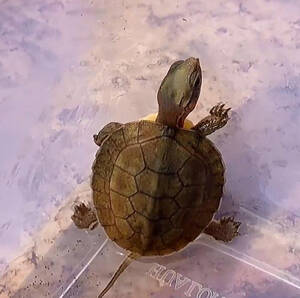Cuora bourreti
IUCN
LCBasic Information
Scientific classification
- name:Cuora bourreti
- Scientific Name:Cuora bourreti,Bourett's Box Turtle,Brandt's box turtle,Bourett's Box Turtle,Cuora galbinifrons bourreti Obst & Reimann
- Outline:Testudines
- Family:Testudinidae B.turtle
Vital signs
- length:15-20cm
- Weight:800-1200g
- lifetime:30-50years
Feature
The head color is brighter, the body is larger than the patterned closed-shell turtle, and is elongated and oval.
Distribution and Habitat
Distributed in Laos (Savannak Province) and central Vietnam (Nghe An Province, Ha Tinh Province, Quang Binh Province, Thua Thien Hue Province, Da Nang, Quang Nam Province and Kon Tum Province).
Appearance
Brandt's box turtle is a medium-sized land turtle. The carapace is about 15-20 cm long. It weighs about 800-1200 grams. The juvenile is about 45-50 mm long and weighs 15-24 grams. The vertebral and marginal shields of the carapace are dark yellow to brown, and the costal shields are light yellow with light yellow ridges, but the pattern is not as clear as that of the yellow-fronted box turtle. The plastron is light yellow with large black spots. There is a joint seam between the pectoral shield and the ventral shield of the plastron, and the front and back halves can move freely and can be completely closed with the carapace. The headrest is yellow with dark spots. The throat is orange-red, and the overall head color is brighter. The limbs are dark brown with bright red and yellow spots. Males and females are roughly the same size. The male's abdomen is slightly concave, the claws are larger, and the tail is thicker and longer.
Details
Bourett's Box Turtle is a medium-sized land turtle.

The Bourreti box turtle was previously published as Cuora galbinifrons bourreti, and was first described by Stuart and Parram in 2004. Parham promoted it to an independent species; in 2006, Fritz et al. questioned its independent species status; in 2012, Spinks et al. published a paper acknowledging its independent species status, which was accepted by TTWG (2014).
Brandt's box turtle is similar to Cuora galbinifrons and Cuora picturata. The difference between the three is that the Cuora galbinifrons has a completely black plastron, while the other two have a light yellow plastron with large black spots. Brandt's box turtle has a brighter head color, a larger body than the patterned box turtle, and is elongated and oval. The patterned box turtle is slightly brighter than Brandt's box turtle, has a smaller body, and is more round.
Brandt's box turtles live in highlands, humid, closed evergreen forests at an altitude of 300-700 meters. The living temperature is 24-30℃ and the relative humidity is 65-80%. Omnivorous: raw meat, small fish, shrimp, fruits and vegetables are all eaten, and artificial bait can also be fed.
Little information is known about the reproduction of Brandt's box turtles in the wild. Under artificial captive breeding conditions, adult females can lay 1-3 eggs per year, and the size of large eggs can reach 55 mm × 30 mm. After the eggs are fertilized, white spots will form on the top of the eggs, which will develop into a band shape within two to three days. The incubation period is 90-97 days.
In the 1980s and 1990s, an estimated 1,500-2,000 entered the international pet trade. The species is quite vulnerable in captivity and successful breeding is rare. As of 2016, fewer than 1,000 are believed to be kept in captivity worldwide. Much of its habitat is protected in the form of national parks, special reserves, and other protected areas, and some of the records of the species come from protected areas. However, protected areas do not completely restrict predators and are not sufficient on their own to guarantee viable populations of the species in its natural habitat.
The main threat to the species is trade in the pet market. The species is in high demand in the international pet trade and in the Asian consumer trade. Captured species are mostly traded illegally through a network of local middlemen before being exported or consumed locally. Although the species is becoming increasingly rare, its increasing economic value has attracted more illegal hunters. Habitat loss and degradation are also significant but more limited threats to the species.
Listed in the IUCN Red List of Threatened Species (IUCN 2018 ver 3.1) - Critically Endangered (CR).
Listed in the Convention on International Trade in Endangered Species of Wild Fauna and Flora (CITES) - Appendix I.
Listed in the Standard Catalogue of Benchmark Values for Aquatic Wildlife (August 27, 2019).
Protect wild animals and stop eating game.
Maintaining ecological balance is everyone's responsibility!








